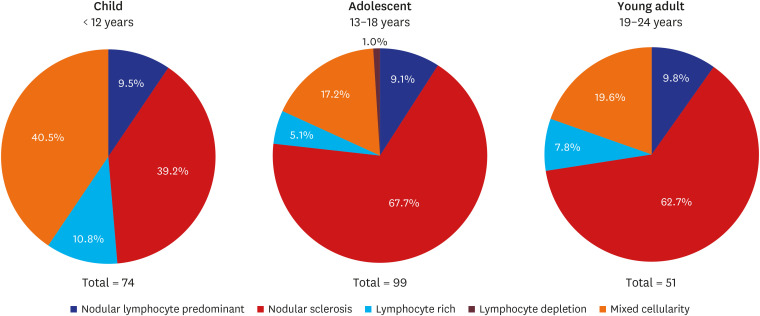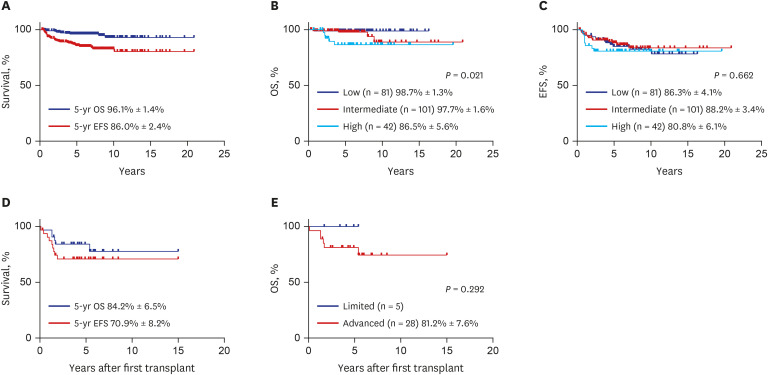J Korean Med Sci.
2020 Dec;35(46):e393. 10.3346/jkms.2020.35.e393.
Clinical Characteristics and Treatment Outcomes in Children, Adolescents, and Young-adults with Hodgkin's Lymphoma: a KPHOG Lymphoma Working-party, Multicenter, Retrospective Study
- Affiliations
-
- 1Department of Pediatrics, Yeungnam University College of Medicine, Daegu, Korea
- 2Department of Pediatrics, Seoul National University College of Medicine, Seoul, Korea
- 3Seoul National University Cancer Institute, Seoul, Korea
- 4Department of Pediatrics, Chonnam National University Hwasun Hospital, Chonnam National University Medical School, Gwangju, Korea
- 5Department of Pediatrics, College of Medicine, The Catholic University of Korea, Seoul, Korea
- 6Department of Hematology, Seoul St. Mary's Hospital, College of Medicine, The Catholic University of Korea, Seoul, Korea
- 7Department of Pediatrics, Pusan National University School of Medicines, Yangsan, Korea
- 8Division of Pediatric Hematology/Oncology, Department of Pediatrics, Asan Medical Center Children's Hospital, University of Ulsan College of Medicine, Seoul, Korea
- 9Department of Pediatrics, Samsung Medical Center, School of Medicine, Sungkyunkwan University, Seoul, Korea
- 10Department of Pediatrics and Research Institute of Clinical Medicine of Jeonbuk National UniversityJeonbuk National University Hospital, Jeonbuk National University Medical School, Jeonju, Korea
- 11Department of Pediatrics, Daegu Fatima Hospital, Daegu, Korea
- 12Department of Internal Medicine, Yeungnam University College of Medicine, Daegu, Korea
- 13Division of Pediatric Hematology and Oncology, Department of Pediatrics, Yonsei University College of Medicine, Seoul, Korea
- 14Department of Pediatrics, Keimyung University School of Medicine, Keimyung University Dongsan Medical Center, Daegu, Korea
- 15Division of Hemato-oncology, Department of Internal Medicine, Keimyung University School of Medicine, Daegu, Korea
- 16Department of Pediatrics, Chungnam National University College of Medicine, Daejeon, Korea
- 17Department of Pediatrics, Gachon University Gil Medical Center, Incheon, Korea
- 18Department of Pediatrics, Dong-A University College of Medicine, Busan, Korea
- 19Department of Hematology, Dong-A University Hospital, Busan, Korea
- 20Department of Pediatrics, Seoul National University Bundang Hospital, Seoul National University College of Medicine, Seongnam, Korea
- 21Department of Pediatrics, Ajou University School of Medicine, Suwon, Korea
- 22Center for Pediatric Oncology, Research Institute and Hospital, National Cancer Center, Goyang, Korea
- 23Department of Pediatrics, Inha University Hospital, Incheon, Korea
- 24Department of Pediatrics, Gyeongsang National University School of Medicine, Jinju, Korea
- 25Department of Pediatrics, School of Medicine, University of Ulsan, Ulsan, Korea
- 26Department of Pediatrics, Daegu Catholic University School of Medicine, Daegu, Korea
- 27Department of Pediatrics, Chungbuk National University Hospital, Cheongju, Korea
- 28Department of Pediatrics, Korea Cancer Center Hospital, Seoul, Korea
- KMID: 2509036
- DOI: http://doi.org/10.3346/jkms.2020.35.e393
Abstract
- Background
Hodgkin's lymphoma (HL) constitutes 10%–20% of all malignant lymphomas and has a high cure rate (5-year survival, around 90%). Recently, interest has increased concerning preventing secondary complications (secondary cancer, endocrine disorders) in long-term survivors. We aimed to study the epidemiologic features and therapeutic outcomes of HL in children, adolescents, and young adults in Korea.
Methods
We performed a multicenter, retrospective study of 224 patients aged < 25 years diagnosed with HL at 22 participating institutes in Korea from January 2007 to August 2016.
Results
A higher percentage of males was diagnosed at a younger age. Nodular sclerosis histopathological HL subtype was most common, followed by mixed cellularity subtype. Eighty-one (36.2%), 101 (45.1%), and 42 (18.8%) patients were classified into low, intermediate, and high-risk groups, respectively. Doxorubicin, bleomycin, vinblastine, dacarbazine was the most common protocol (n = 102, 45.5%). Event-free survival rate was 86.0% ± 2.4%, while five-year overall survival (OS) rate was 96.1% ± 1.4%: 98.7% ± 1.3%, 97.7% ± 1.6%, and 86.5% ± 5.6% in the low, intermediate, and high-risk groups, respectively (P = 0.021). Five-year OS was worse in patients with B-symptoms, stage IV disease, highrisk, splenic involvement, extra-nodal lymphoma, and elevated lactate dehydrogenase level. In multivariate analysis, B-symptoms and extra-nodal involvement were prognostic factors for poor OS. Late complications of endocrine disorders and secondary malignancy were observed in 17 and 6 patients, respectively.
Conclusion
This is the first study on the epidemiology and treatment outcomes of HL in children, adolescents, and young adults in Korea. Future prospective studies are indicated to develop therapies that minimize treatment toxicity while maximizing cure rates in children, adolescents, and young adults with HL.
Keyword
Figure
Reference
-
1. Crombie JL, LaCasce AS. Current considerations in AYA Hodgkin lymphoma. Br J Haematol. 2019; 184(1):72–81. PMID: 30460695.
Article2. Meyer RM. Hodgkin lymphoma. In : Bleyer A, Barr R, Ries L, Whelan J, Ferrari A, editors. Cancer in Adolescents and Young Adults. 2nd ed. Cham: Springer;2017. p. 119–133.3. Foltz LM, Song KW, Connors JM. Hodgkin's lymphoma in adolescents. J Clin Oncol. 2006; 24(16):2520–2526. PMID: 16735704.
Article4. Kahn JM, Kelly KM. Adolescent and young adult Hodgkin lymphoma: raising the bar through collaborative science and multidisciplinary care. Pediatr Blood Cancer. 2018; 65(7):e27033. PMID: 29603618.
Article5. Jung KW, Won YJ, Kong HJ, Lee ES. Cancer statistics in Korea: incidence, mortality, survival, and prevalence in 2016. Cancer Res Treat. 2019; 51(2):417–430. PMID: 30913865.
Article6. Statistics Korea. Cancer incidence in 2016. Accessed December 29, 2019. http://kosis.kr/.7. Aisenberg AC. Historical review of lymphomas. Br J Haematol. 2000; 109(3):466–476. PMID: 10886191.
Article8. Englund A, Glimelius I, Rostgaard K, Smedby KE, Eloranta S, Molin D, et al. Hodgkin lymphoma in children, adolescents and young adults - a comparative study of clinical presentation and treatment outcome. Acta Oncol. 2018; 57(2):276–282. PMID: 28760045.
Article9. Herbertson R, Hancock BW. Hodgkin lymphoma in adolescents. Cancer Treat Rev. 2005; 31(5):339–360. PMID: 15951118.
Article10. De Re V, Caggiari L, Repetto O, Mussolin L, Mascarin M. Classical Hodgkin's lymphoma in the era of immune checkpoint inhibition. J Clin Med. 2019; 8(10):1596.
Article11. Straus DJ. Limited-stage Hodgkin lymphoma: minimizing toxicity. Cancer J. 2018; 24(5):223–229. PMID: 30247257.12. Hasenclever D, Diehl V, Armitage JO, Assouline D, Björkholm M, Brusamolino E, et al. A prognostic score for advanced Hodgkin's disease. N Engl J Med. 1998; 339(21):1506–1514. PMID: 9819449.
Article13. Smolewski P, Robak T, Krykowski E, Blasiñska-Morawiec M, Niewiadomska H, Pluzanska A, et al. Prognostic factors in Hodgkin's disease: multivariate analysis of 327 patients from a single institution. Clin Cancer Res. 2000; 6(3):1150–1160. PMID: 10741746.14. Schwartz CL, Chen L, McCarten K, Wolden S, Constine LS, Hutchison RE, et al. Childhood Hodgkin International Prognostic Score (CHIPS) predicts event-free survival in Hodgkin lymphoma: a report from the Children's Oncology Group. Pediatr Blood Cancer. 2017; 64(4):e26278.
Article15. Reedijk AM, Zijtregtop EA, Coebergh JW, Meyer-Wentrup FA, Hebeda KM, Zwaan CM, et al. Improved survival for adolescents and young adults with Hodgkin lymphoma and continued high survival for children in the Netherlands: a population-based study during 1990-2015. Br J Haematol. 2020; 189(6):1093–1106. PMID: 32030738.
Article16. Lister TA, Crowther D, Sutcliffe SB, Glatstein E, Canellos GP, Young RC, et al. Report of a committee convened to discuss the evaluation and staging of patients with Hodgkin's disease: Cotswolds meeting. J Clin Oncol. 1989; 7(11):1630–1636. PMID: 2809679.
Article17. Stiller CA. What causes Hodgkin's disease in children? Eur J Cancer. 1998; 34(4):523–528. PMID: 9713303.
Article18. Kelly KM, Cole PD, Pei Q, Bush R, Roberts KB, Hodgson DC, et al. Response-adapted therapy for the treatment of children with newly diagnosed high risk Hodgkin lymphoma (AHOD0831): a report from the Children's Oncology Group. Br J Haematol. 2019; 187(1):39–48. PMID: 31180135.
Article19. Kahn JM, Kelly KM, Pei Q, Bush R, Friedman DL, Keller FG, et al. Survival by race and ethnicity in pediatric and adolescent patients with Hodgkin lymphoma: a Children's Oncology Group study. J Clin Oncol. 2019; 37(32):3009–3017. PMID: 31539308.
Article20. Federico M, Bellei M, Brice P, Brugiatelli M, Nagler A, Gisselbrecht C, et al. High-dose therapy and autologous stem-cell transplantation versus conventional therapy for patients with advanced Hodgkin's lymphoma responding to front-line therapy. J Clin Oncol. 2003; 21(12):2320–2325. PMID: 12805333.
Article21. Schmitz N, Pfistner B, Sextro M, Sieber M, Carella AM, Haenel M, et al. Aggressive conventional chemotherapy compared with high-dose chemotherapy with autologous haemopoietic stem-cell transplantation for relapsed chemosensitive Hodgkin's disease: a randomised trial. Lancet. 2002; 359(9323):2065–2071. PMID: 12086759.
Article22. Broccoli A, Zinzani PL. The role of transplantation in Hodgkin lymphoma. Br J Haematol. 2019; 184(1):93–104. PMID: 30407612.
Article23. Proctor SJ, Jackson GH, Lennard A, Angus B, Wood K, Lucraft HL, et al. Strategic approach to the management of Hodgkin's disease incorporating salvage therapy with high-dose ifosfamide, etoposide and epirubicin: a Northern Region Lymphoma Group study (UK). Ann Oncol. 2003; 14(Suppl 1):i47–i50. PMID: 12736232.
Article24. Santoro A, Mazza R, Pulsoni A, Re A, Bonfichi M, Zilioli VR, et al. Bendamustine in combination with gemcitabine and vinorelbine is an effective regimen as induction chemotherapy before autologous stem-cell transplantation for relapsed or refractory Hodgkin lymphoma: final results of a multicenter phase II study. J Clin Oncol. 2016; 34(27):3293–3299. PMID: 27382096.
Article25. Barr RD, Ferrari A, Ries L, Whelan J, Bleyer WA. Cancer in adolescents and young adults: a narrative review of the current status and a view of the future. JAMA Pediatr. 2016; 170(5):495–501. PMID: 26999630.26. Ng AK. Current survivorship recommendations for patients with Hodgkin lymphoma: focus on late effects. Blood. 2014; 124(23):3373–3379. PMID: 25428219.
Article27. Inskip PD, Robison LL, Stovall M, Smith SA, Hammond S, Mertens AC, et al. Radiation dose and breast cancer risk in the childhood cancer survivor study. J Clin Oncol. 2009; 27(24):3901–3907. PMID: 19620485.
Article28. Travis LB, Gilbert E. Lung cancer after Hodgkin lymphoma: the roles of chemotherapy, radiotherapy and tobacco use. Radiat Res. 2005; 163(6):695–696. PMID: 16044495.29. Eichenauer DA, Thielen I, Haverkamp H, Franklin J, Behringer K, Halbsguth T, et al. Therapy-related acute myeloid leukemia and myelodysplastic syndromes in patients with Hodgkin lymphoma: a report from the German Hodgkin Study Group. Blood. 2014; 123(11):1658–1664. PMID: 24478403.
Article30. van Dorp W, van Beek RD, Laven JS, Pieters R, de Muinck Keizer-Schrama SM, van den Heuvel-Eibrink MM. Long-term endocrine side effects of childhood Hodgkin's lymphoma treatment: a review. Hum Reprod Update. 2012; 18(1):12–28. PMID: 21896559.
Article31. Demirkaya M, Sevinir B, Sağlam H, Özkan L, Akacı O. Thyroid functions in long-term survivors of pediatric Hodgkin's lymphoma treated with chemotherapy and radiotherapy. J Clin Res Pediatr Endocrinol. 2011; 3(2):89–94. PMID: 21750638.



